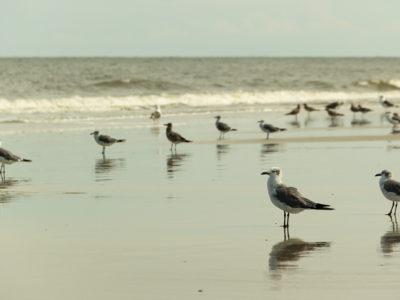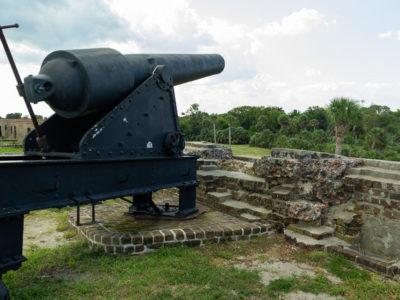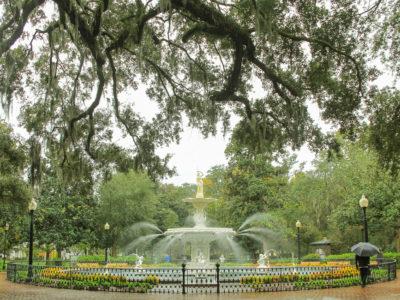Step on the cobblestone streets of the Old and Historic District of Charleston, in South Carolina, to see a sample of American architecture from the 17th century to the early 20th century in a variety of styles.
Over 2000 historic buildings tell the story of Charleston as you peek through artistic iron gates and as you walk past hotels and grandiose antebellum mansions with wraparound porches that could fit a dozen New York City studio apartments.
Add a scenic environment dotted with huge live oak trees and waterfront parks, and it’s easy to see why “The Holy City” – its skyline is filled with steeples from its many churches- has been number one on the list of top travel destinations for several years.
A visit to Charleston is also an opportunity to learn about the not-so-beautiful side of its history. The thriving economy that made possible the construction and upkeep of these mansions was mainly a product of the slave trade. A few people lived a fabulous life in this prosperous town because many other people were sold as a commodity and subjected to forced labour.
Some lived under these fancy roofs or in the slave quarters a few feet away from the main house.
But there is also a story of triumph with the Civil Rights movement, and some stories of courage from brave enslaved people who achieved freedom, overcoming what seemed impossible.
I prepared a walking itinerary with my favourite landmarks in Charleston: historic houses, blacksmiths masterpieces, 18th-century churches, waterfront parks, and sites that shaped the history of the United States.
Some houses you can visit, some are museums, some you can see only from the outside, and some are bed and breakfasts you can stay in.
Charleston is a great destination for a weekend trip. While you’re here you can visit other nearby attractions like the Magnolia Plantation and Gardens, the historic town of Beaufort (South Carolina), and stop at the many wildlife refuge areas.
It can also be done as a day trip from Hilton Head Island, or from historic Savannah.
I’ll start this itinerary at the point where it all began once the settlers crossed the Ashley River. We’ll then walk south to the White Point Garden Park, go back north on Meeting Street and end the tour in the French Quarter and Rainbow Row. Enjoy!
Disclosure: This post contains some affiliate links. If you make a purchase through those links I will earn a commission at no additional cost to you (zero, nada). To check the full disclaimer, click here.
Table of Contents
Charleston: The Only British Walled City in North America (and the Story of Robert Smalls)
When was Charleston founded?
It all started when, in 1670, a group of English people settled down in what is today Charles Towne Landing State Historic Site. Ten years later they relocated to the other side of the Ashley River, and Charles Town was born, eventually growing into the city of Charleston.
As the town became prosperous and a busy commercial port their main concern was: Oh, no. The French want to invade us! The Spanish want to invade us! The Indians (as they called the indigenous people) want to invade us! What are we going to do?
What did they do? They built a wall.
By 1711 a massive six-feet wide and 10-feet tall brick seawall surrounded Charles Town, with bastions (small forts) in every corner, redans (protruding triangles to place cannons), and a battery.
But like a pair of jeans after too many holiday treats, the wall constricted the expansion of the town and by 1730 it was demolished, except for the side facing the harbour which remained until 1784.
Today, after some excavations that unveiled this historic landmark, you can see a portion of the wall and the Tradd Street redan as you walk along East Bay Street (at East Bay Street and Tradd Street).
Keep walking south until you reach 40 East Bay Street. You’ll find Missroon House, built in 1789 (with later additions), and the previous site of Granville Bastion.
The city wall runs beneath this house.

A few feet from here you’ll see the waters that Robert Smalls sailed to find his freedom. He was an enslaved pilot who, along with other six men, seized a Confederate vessel (The Planter) and delivered it to the Federal fleet that was out in the sea blocking the harbour.
You’ll hear a lot about Smalls in his native Beaufort, another beautiful historic town in South Carolina. He started his journey as an enslaved pilot and ended up serving five terms in the United States Congress, proposing the state’s first public system.
A fascinating story.
The Historic Houses of The Battery and Oyster Point
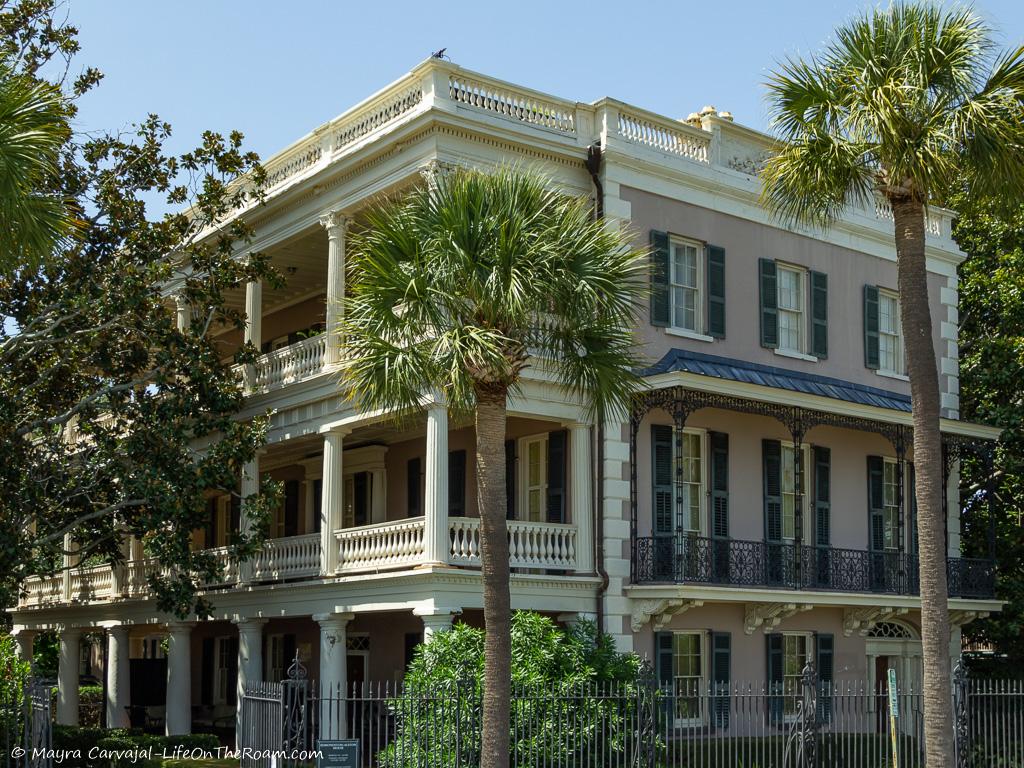
Some of the most impressive historic houses are located in the Battery, a scenic waterfront area in the southernmost point of Charleston, and a historic landmark where many battles were fought during the Civil War and the Revolutionary War.
East Bay St. will turn into East Battery Street where you’ll find one of the first mansions showing the typical Charleston Single House: a long rectangular shape with a narrow front towards the street, adapting to the shape of the lot.
The Edmonston-Alston House (21 East Battery), a house museum, was built in 1825 in late Federal style and was remodeled in the Greek Revival style.
The White Point Garden Park (formerly known as Oyster Point – take a look at the ground and you’ll know why-) is a lovely spot to sit on a bench and enjoy the view under the shade of live oak trees.

Once you’re ready to get going another impressive historic mansion is waiting for you at 20 South Battery: The Stevens-Lather House, built in 1843 and remodeled in the Second Empire style by architect John Henry Devereux. The house is now a hotel, the 20 South Battery. Make a reservation to stay at the 20 South Battery if you want to see the interiors as only guests can tour it.

The Best of Charleston Architecture along Meeting Street
Meeting Street is one of the oldest streets in Charleston and it’s packed with beautiful historic houses, churches, and public buildings. If you’re super limited in time and you can’t see it all, take a walk along this street and you’ll see a lot.
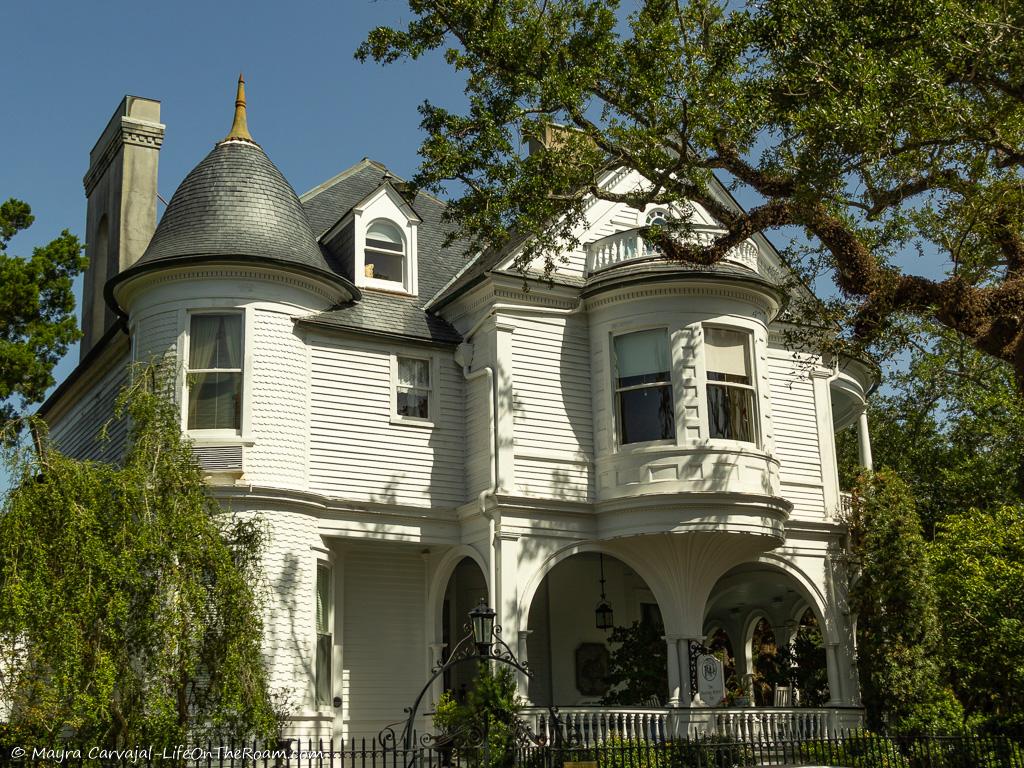
It was love at first after seeing Two Meeting Street Inn, a late 19th-century house featuring arches and turrets that is now a Bed and Breakfast. The money to build this beauty was a generous wedding gift from the father of the bride.
Don’t miss the magnificent wrought-iron sconces flanking the entrance door right across the street in 1 Meeting Street.
Next on the list is the Williams Mansion (#16) (c. 1876) and its lovely arched windows typical of the Italianate style.
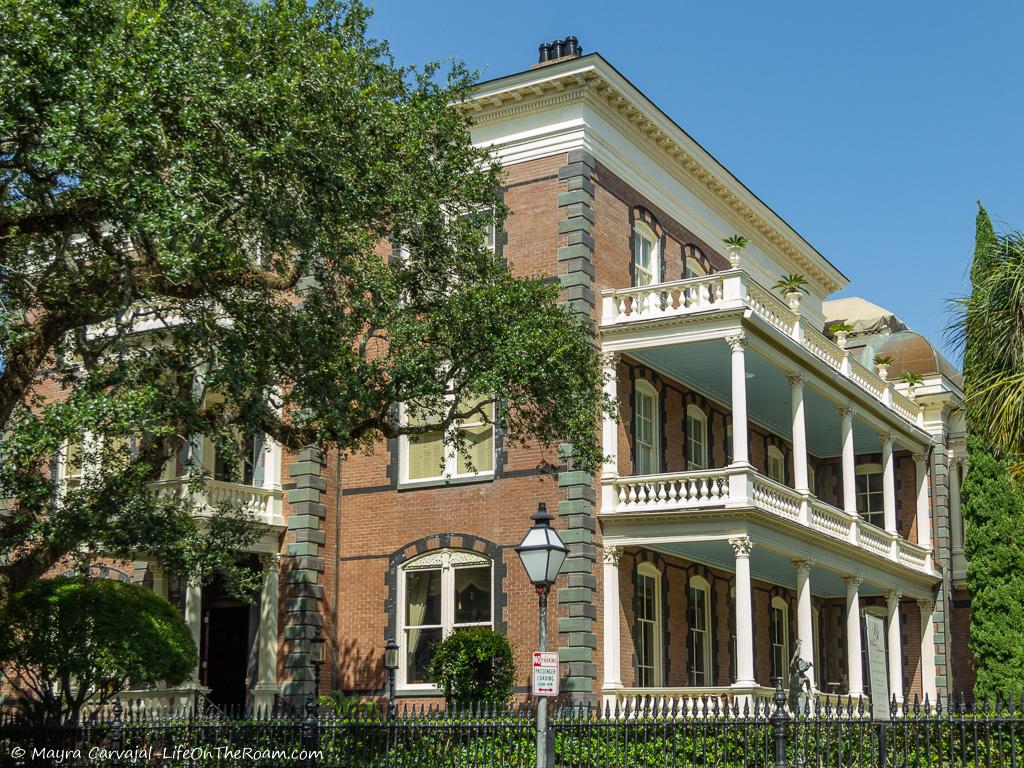
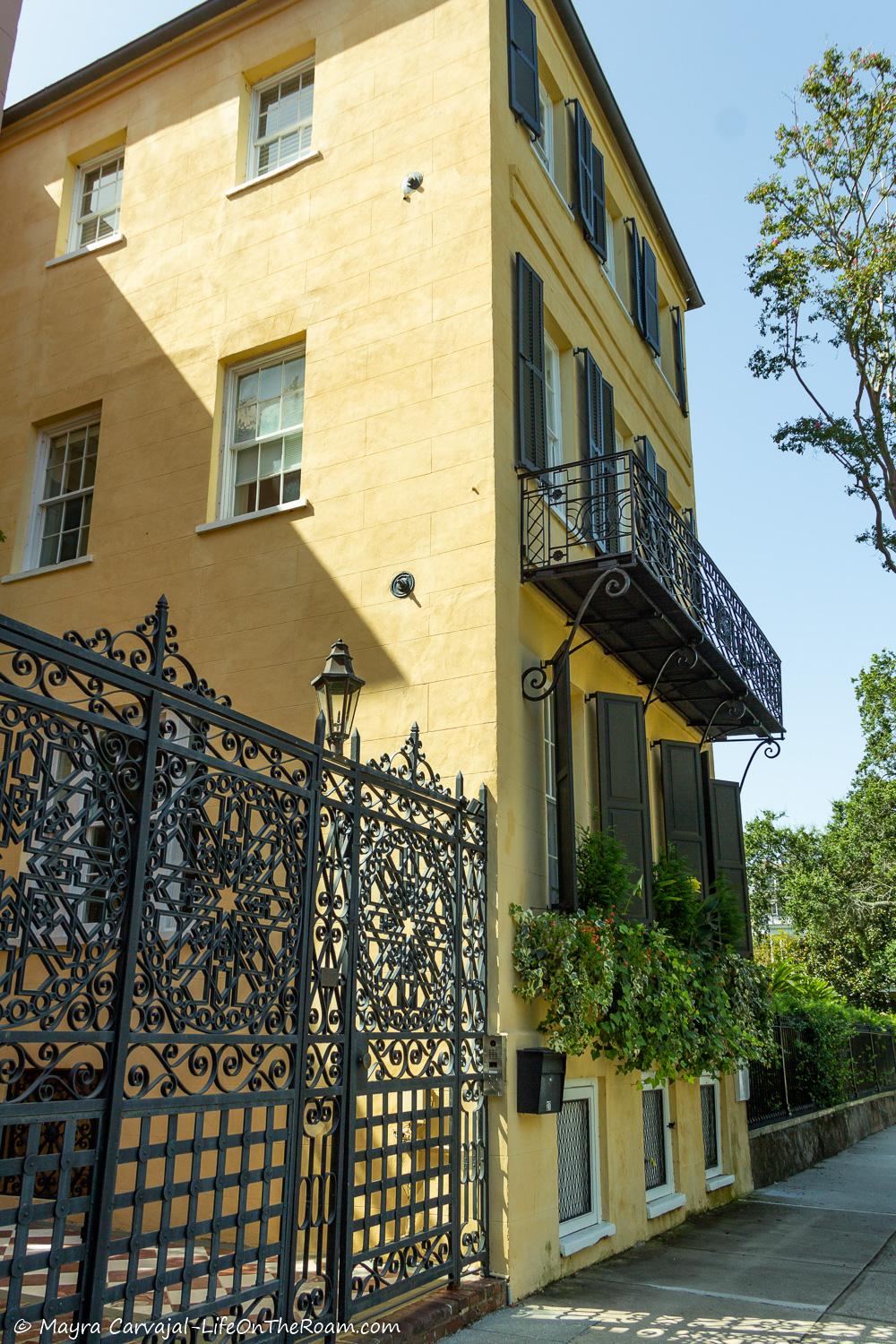
I had another I have to stop moment at the Joseph Yates House (#27) (c. 1815). It was all about the jaw-dropping iron gate and the second-floor ironwork (a 20th-century addition). The house is another example of the typical single house in a prosperous Charleston between the late 18th century and early 19th century, with a narrow façade to the street.
You’ll find another two lovely iron gates (of the many in Charleston) at #37, the James Simmons House (c. 1760), and at #45, Eagle Nest.
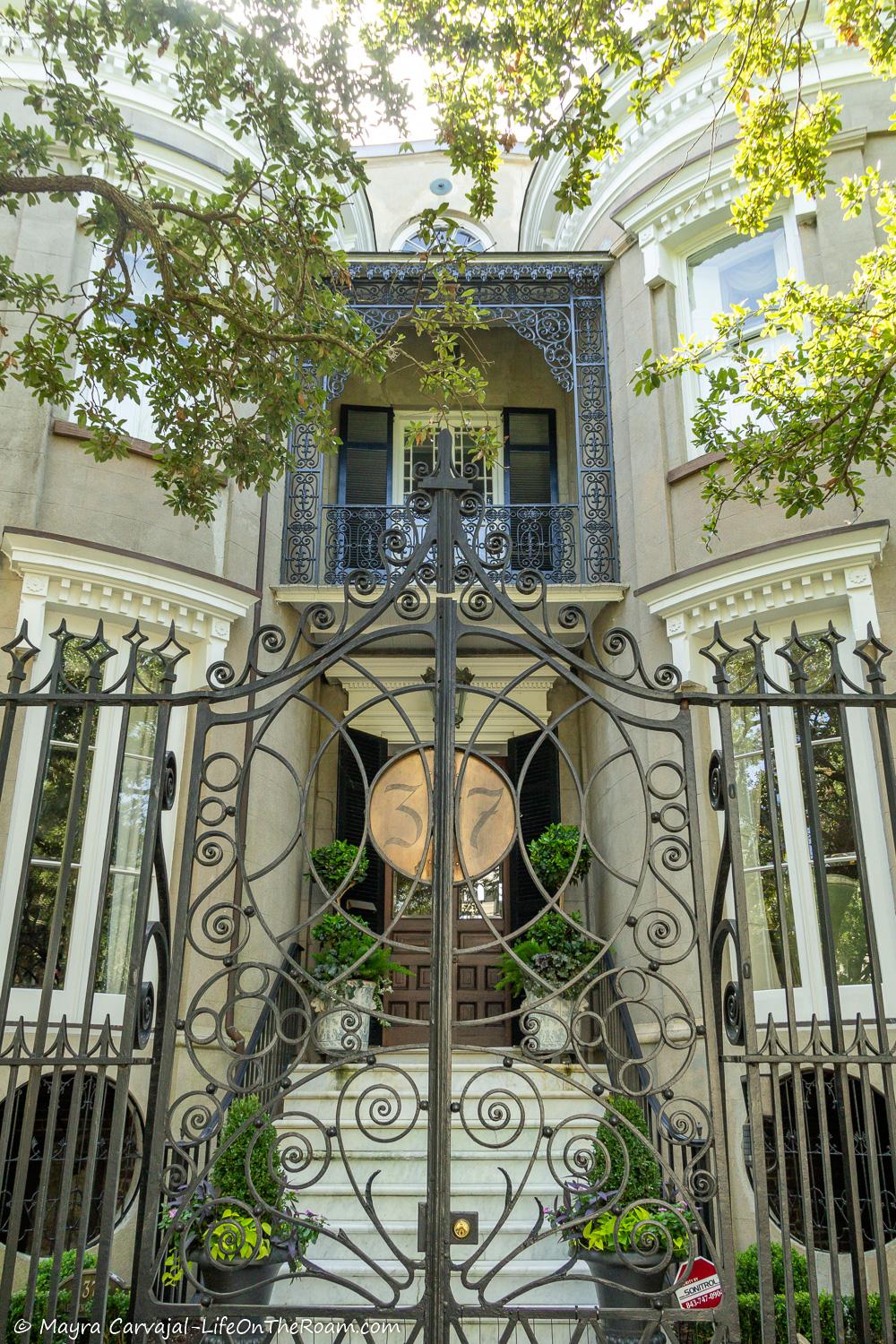
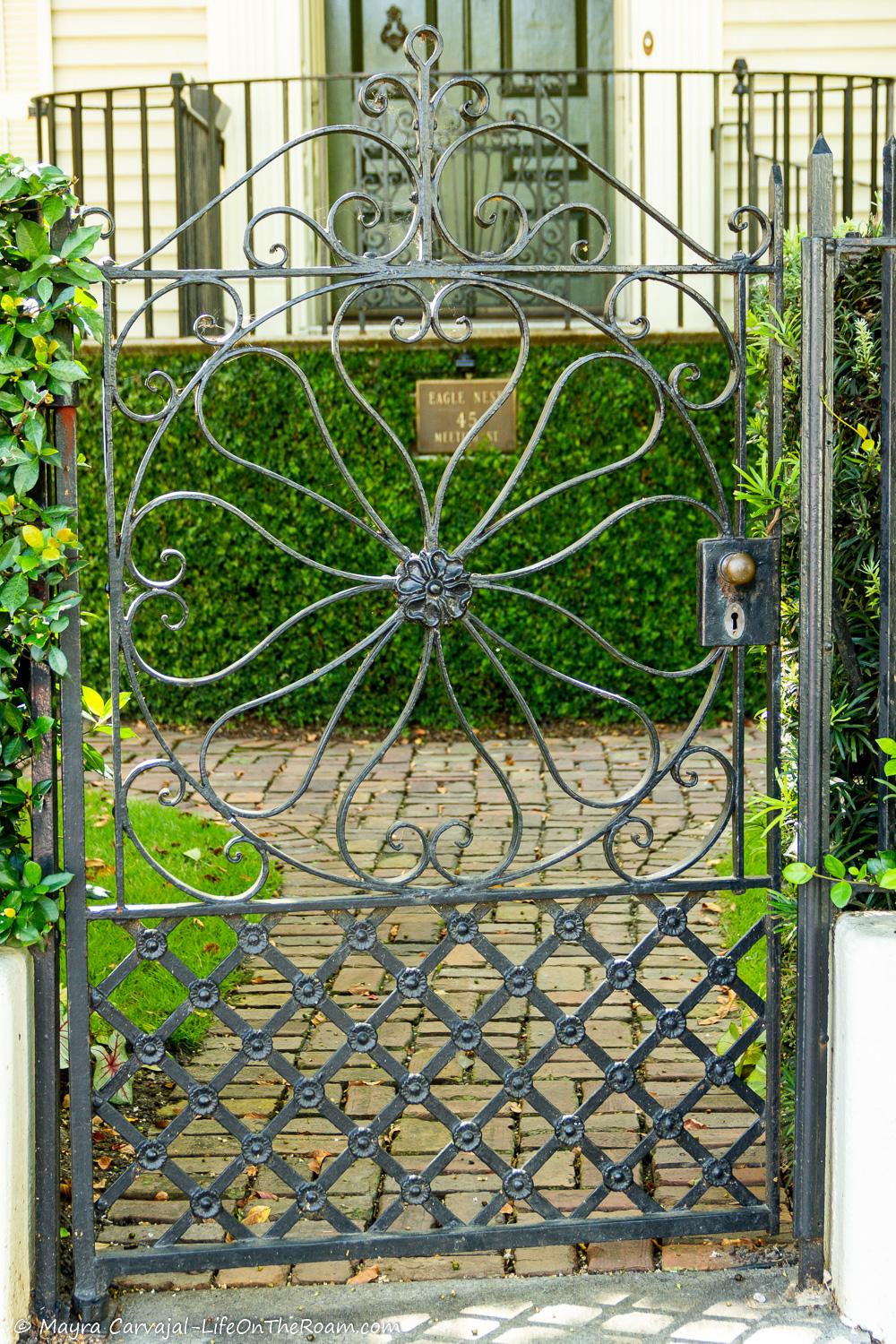
The James Simmons house (Georgian-style), was part of the original plan of the city, known as “The Grand Modell of Charles Town”, an ambitious plan concocted by people with a lot of money to build a perfect city. The ironwork on the second-floor porch is also stunning.
The iron gate that makes you go Wow! at #45 is the work of a talented man named Philip Simmons. He was only 13 years old when he started learning the fine art of blacksmith from the master Peter Simmons, who learned it from his father, an enslaved man.
Not only did Philip and Peter share their last name, but also their passion for creating beautiful ironwork. And the answer to a question they must have heard ten thousand times is no, they weren’t related.
The quality of his artwork, with tight loops and curves that take your eyes through interconnected rollercoasters adorning gates, windows, and balconies across buildings and parks, earned him multiple awards.
Charleston has one of the finest ironwork you’ll see in the United States and the world, embellishing houses like lace made out of iron.
Want more in depth information about Charleston and its history? Check out this:
Historic Charleston Walking Tour: this 2-hour sightseeing tour with a licensed guide is a great way to learn more about the historic district of Charleston in a short time.
Book this tour, with a rating of 4.9/5 based on more than 4,930 reviews.
Next, at #51, you’ll see a house museum where you can tour the interiors. The Nathaniel Russel House (c. 1808), a neoclassical gem.
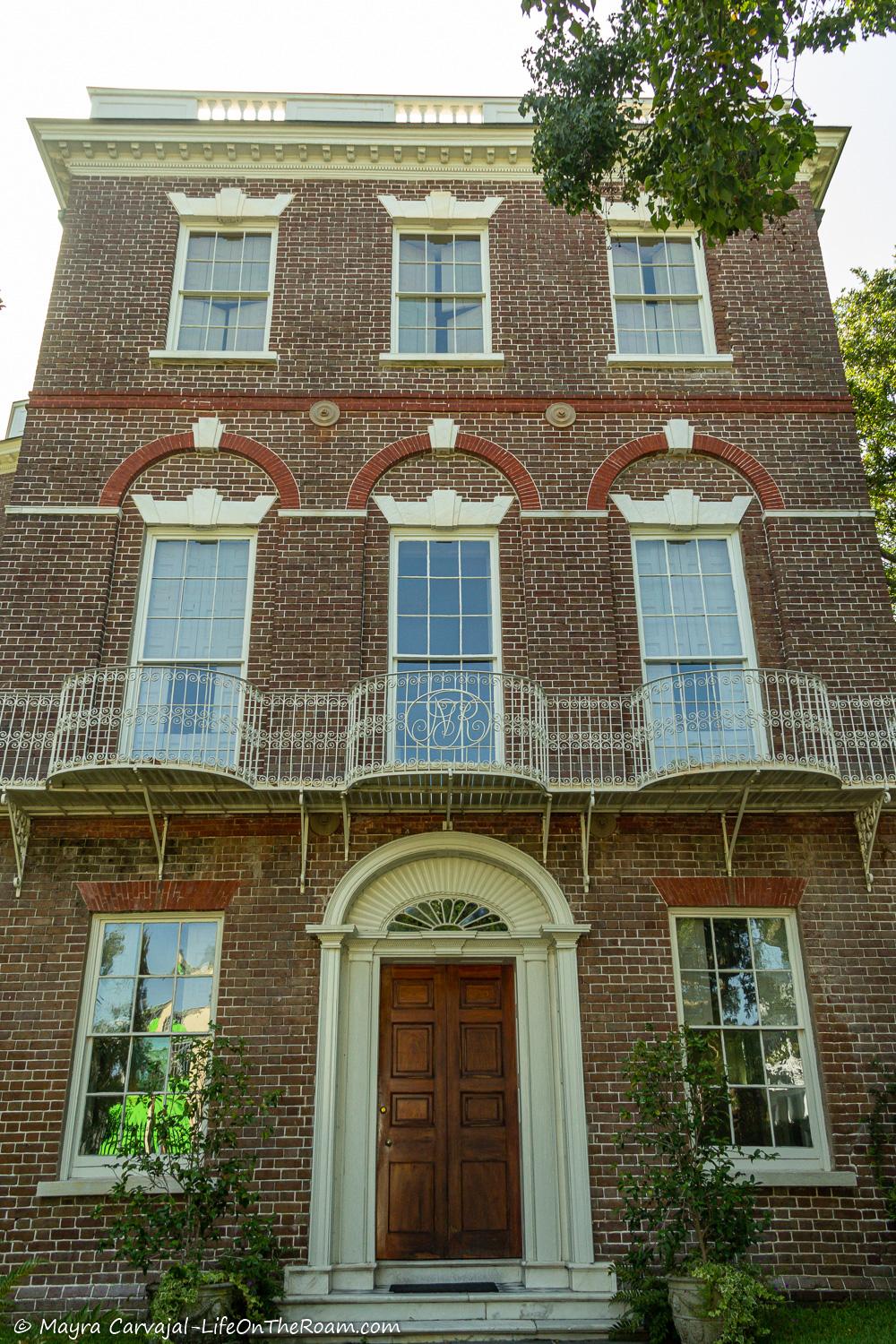
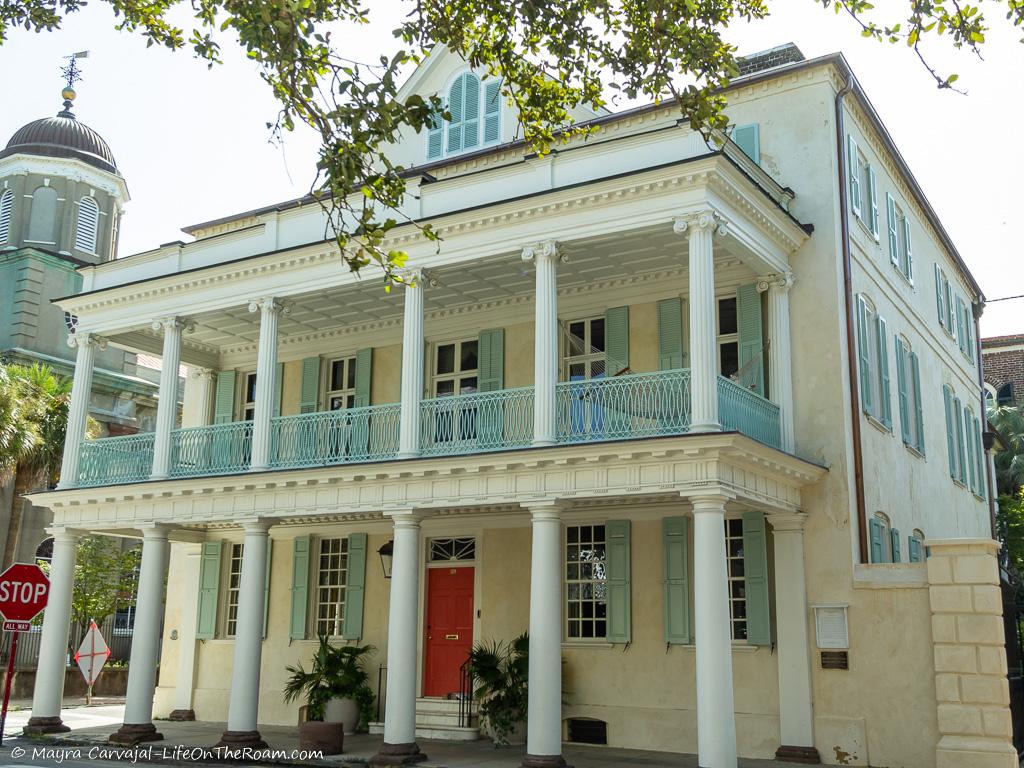
A Georgian gem awaits for you at #59, the Brandford-Horry House (c. 1751) in a Georgian style. The piazzas (a porch or veranda, Charleston style) were added in 1826 with Doric columns on the ground floor and Ionic columns on the second (and a beautiful panelling).
Across the street, #60 is like a window shop of architectural elements. Built in 1740 and renovated in the 1890s, when the new owner added funky features like the horseshoe arch on the second floor. It immediately caught my attention. Of course, there are other elements typical of the Victorian style, like the turret and the bay windows.
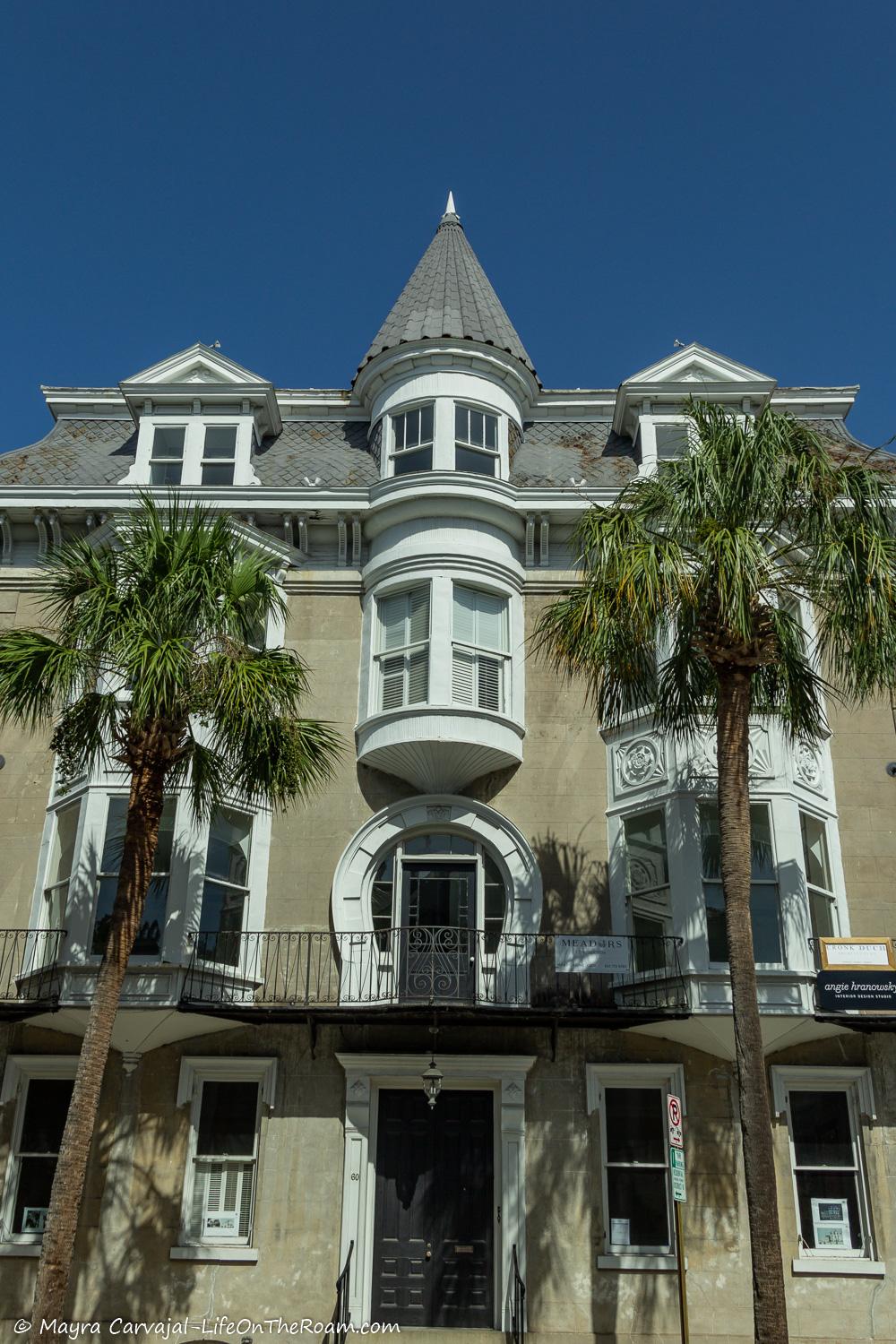
All this combined with the bracketed cornice and the mansard roof with dormer windows create an impressive façade that surprisingly doesn’t look like a messy lasagna.
Maybe the rigorous symmetry and the muted colour helps. Delightful. One of my favourites!
The Philip Moore House (#65), The John Cordes Prioleau House (#68), and the Poyas-Mordecai House (#69) are more examples of the typical single house in Charleston

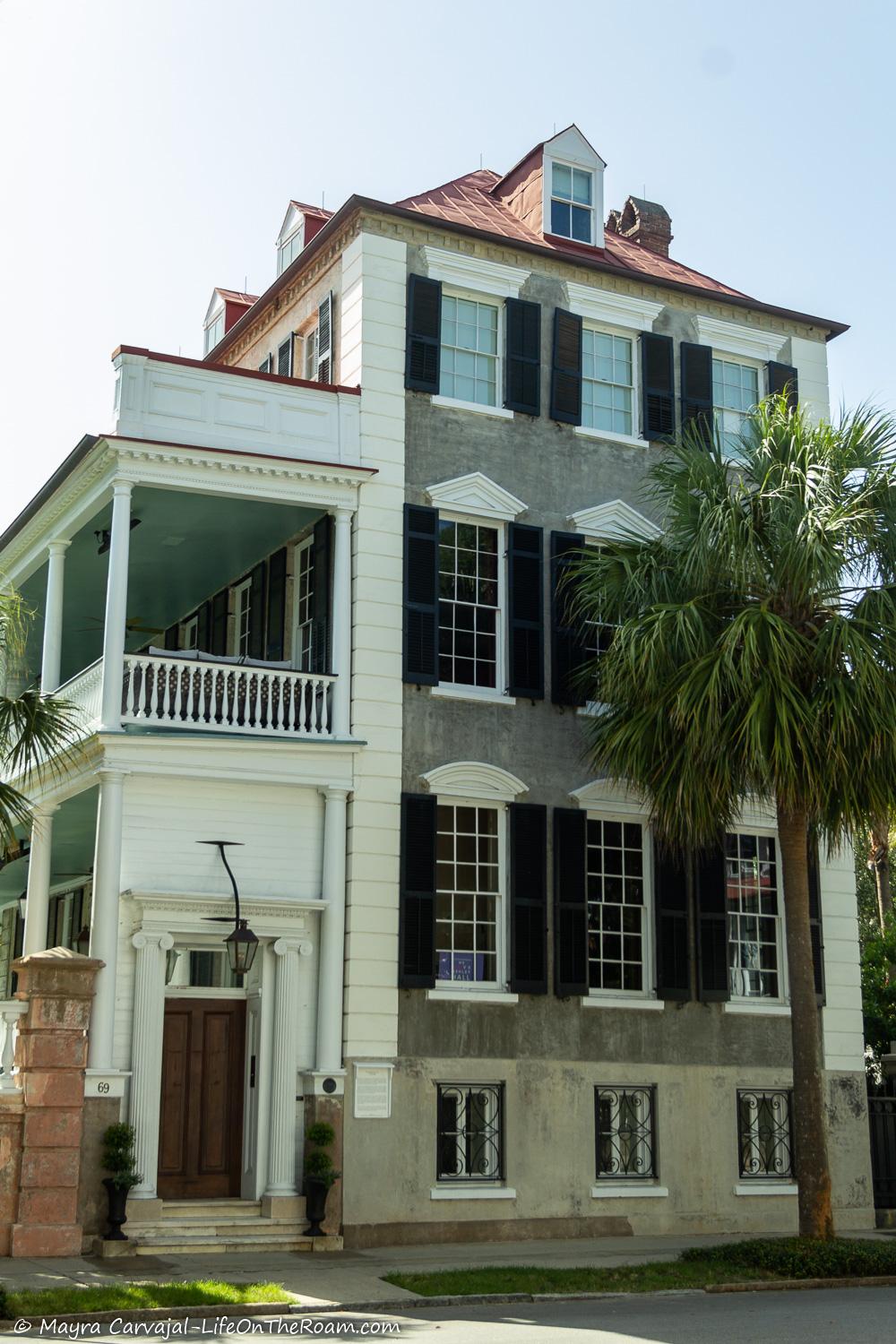
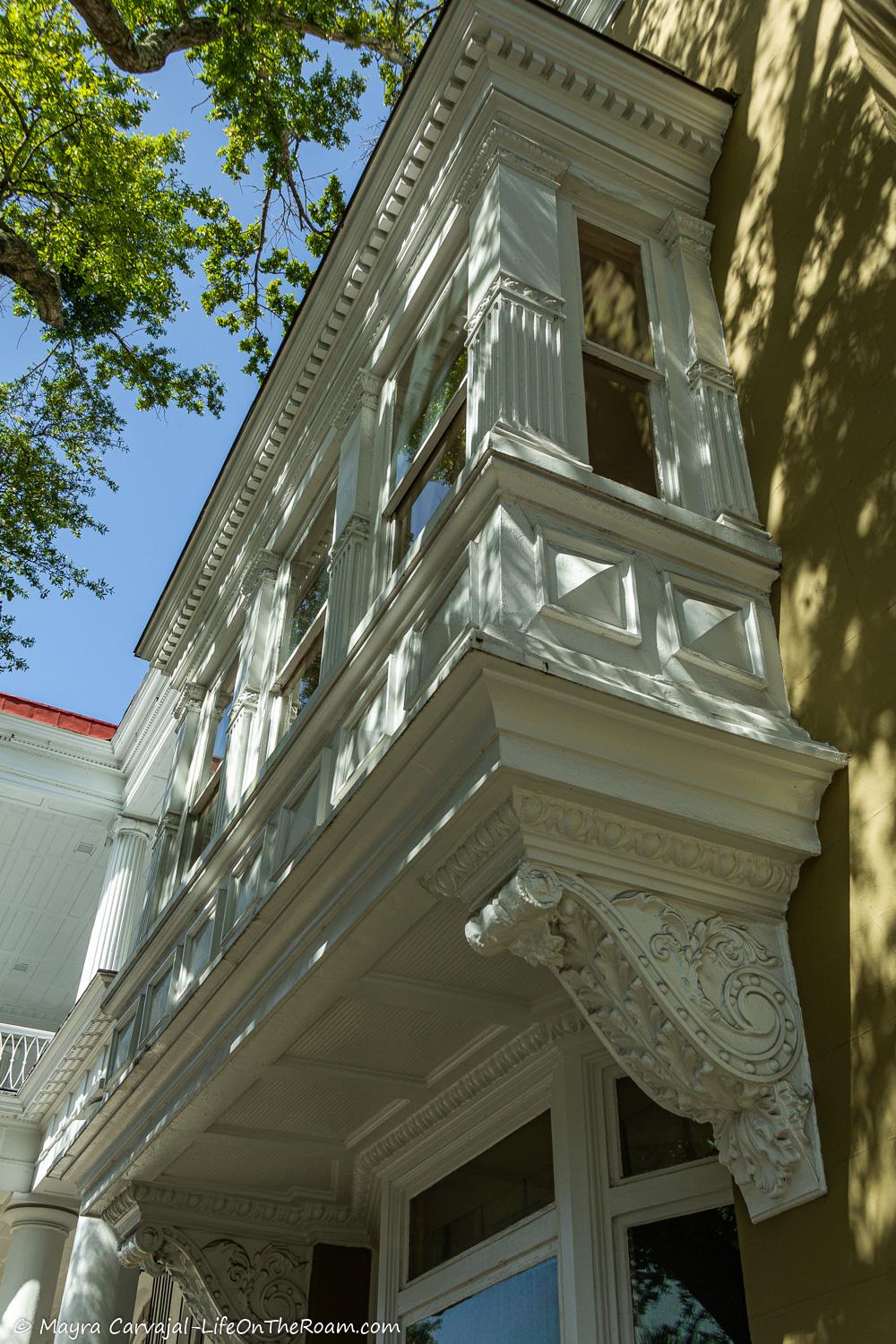
Built in 1800, 1810, and 1796-1800 respectively and were part of the Grand Modell of Charles Town I mentioned in #37. Notice the beautiful Renaissance Revival details of the Prioleau House and the addition of the two-story Greek Revival style piazza (on the left) to the Poyas-Mordecai House in the late 1800s.
From residential we’ll switch to civic architecture. The French Huguenots (French protestants) hired architect Gabriel Manigault to build The South Carolina Society Hall (#72) between 1799-1804. The fine building was part school for orphan girls, part meeting palace and it’s used now for meetings, weddings, and other celebrations.
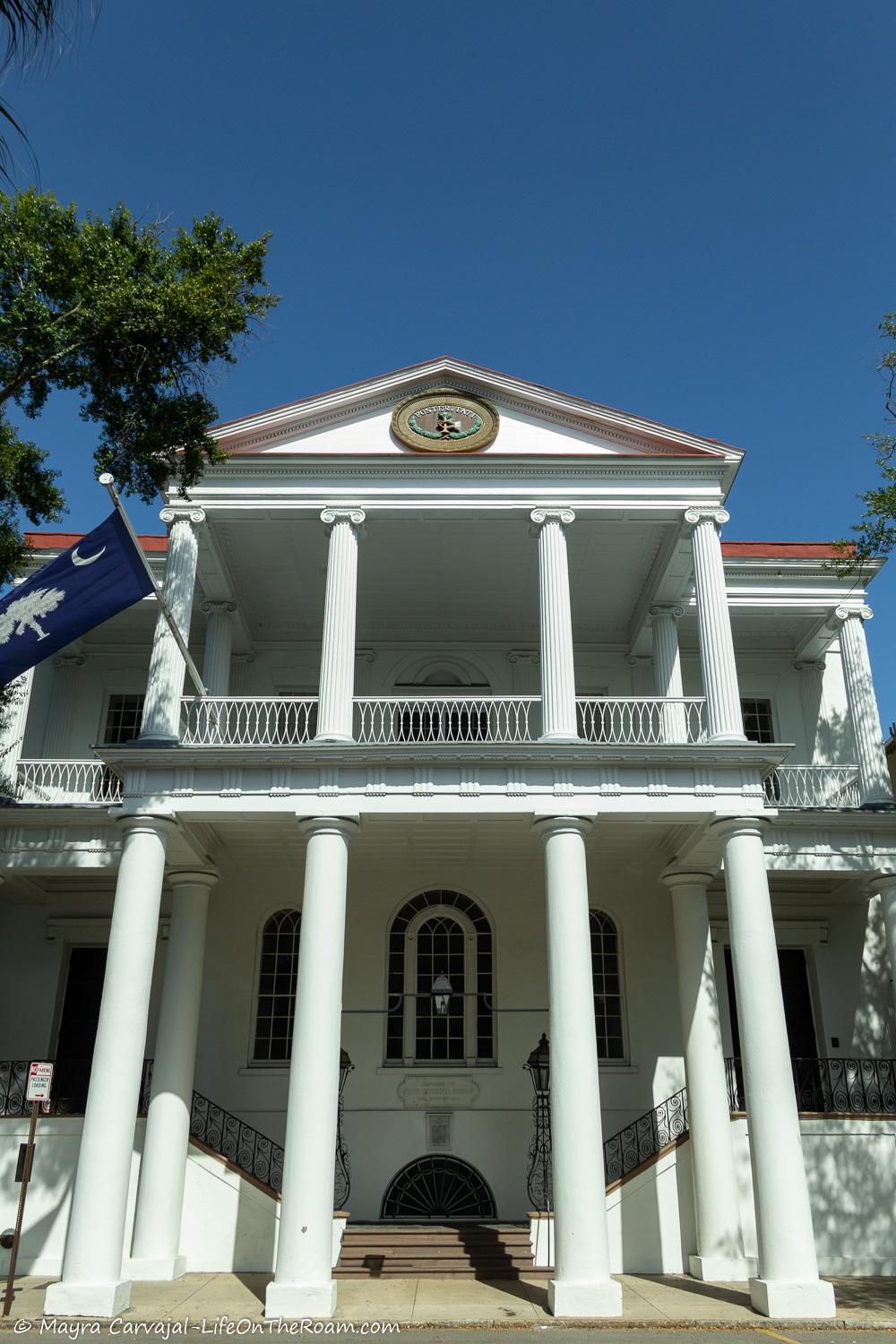
The point where Meeting Street reaches Broad Street is called The Four Corners of Law. At least this is how Robert Ripley (as in Ripley’s Believe It or Not!) named this intersection in the 1930s. Four buildings face each other, each one representing a branch of law:

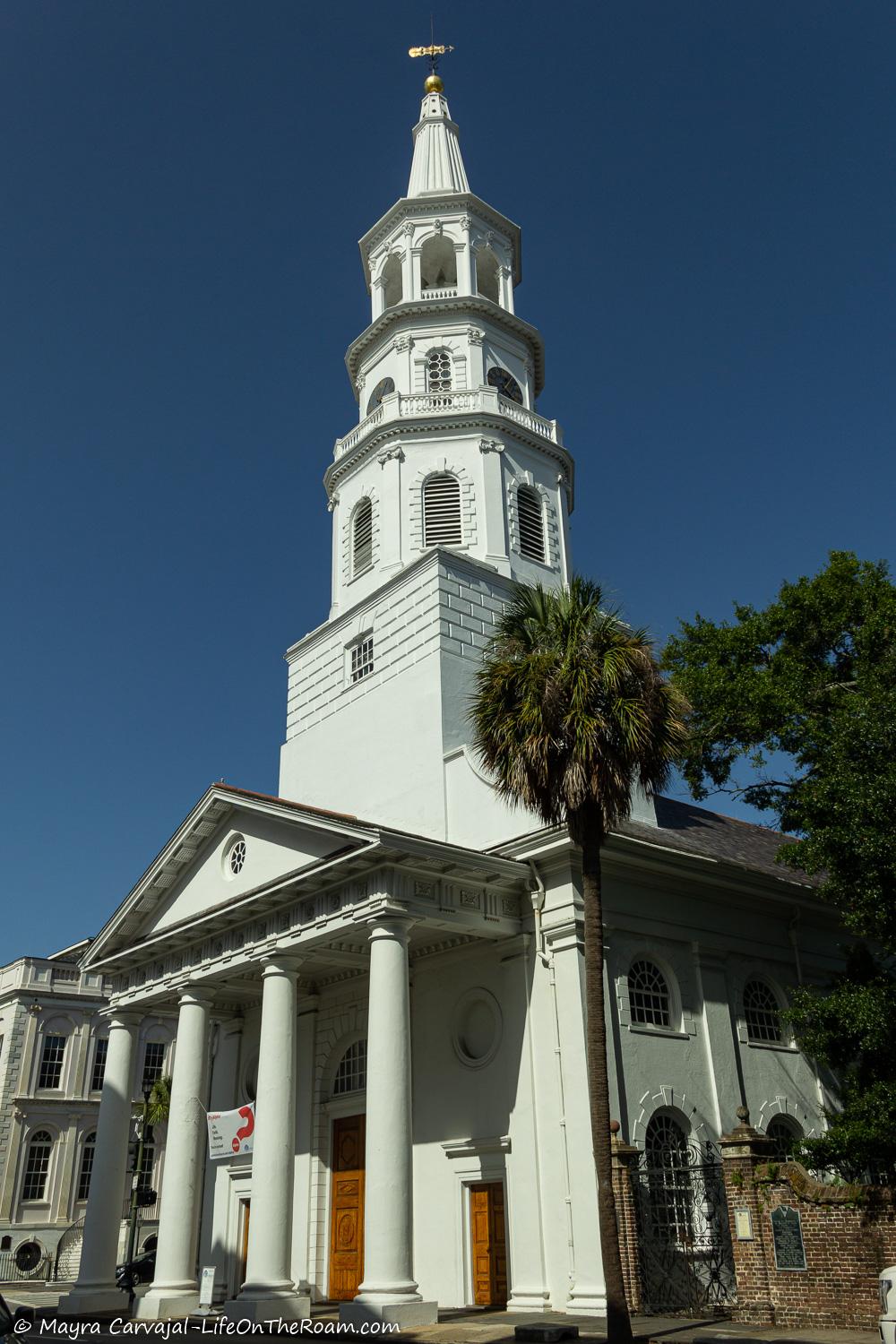
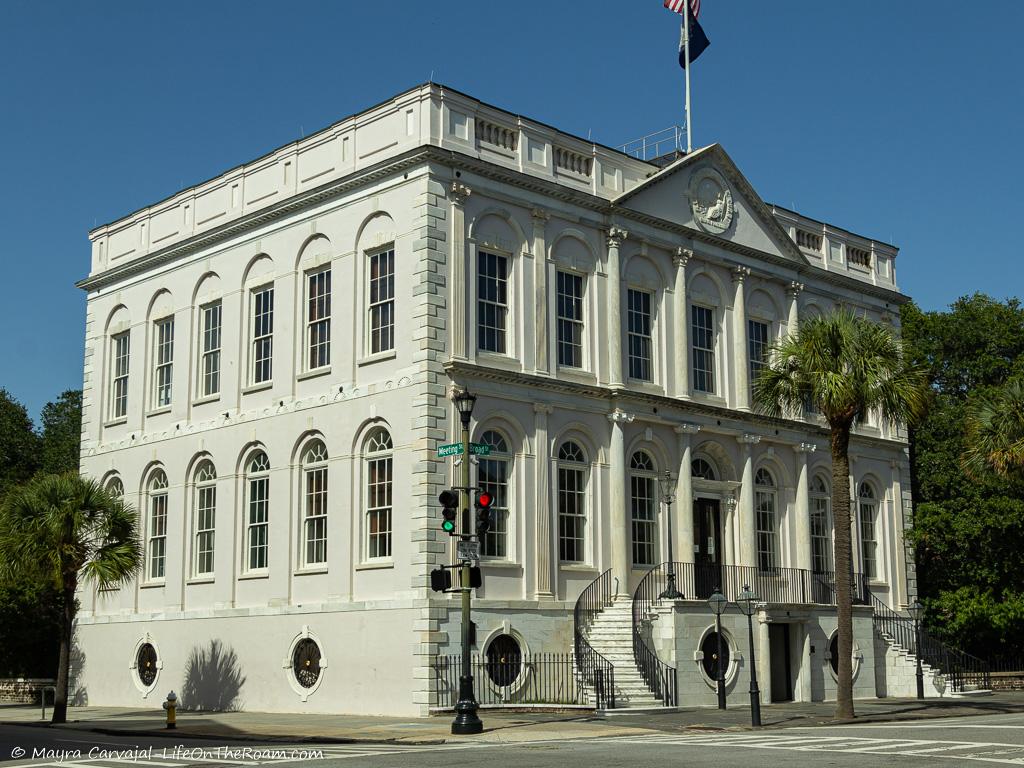
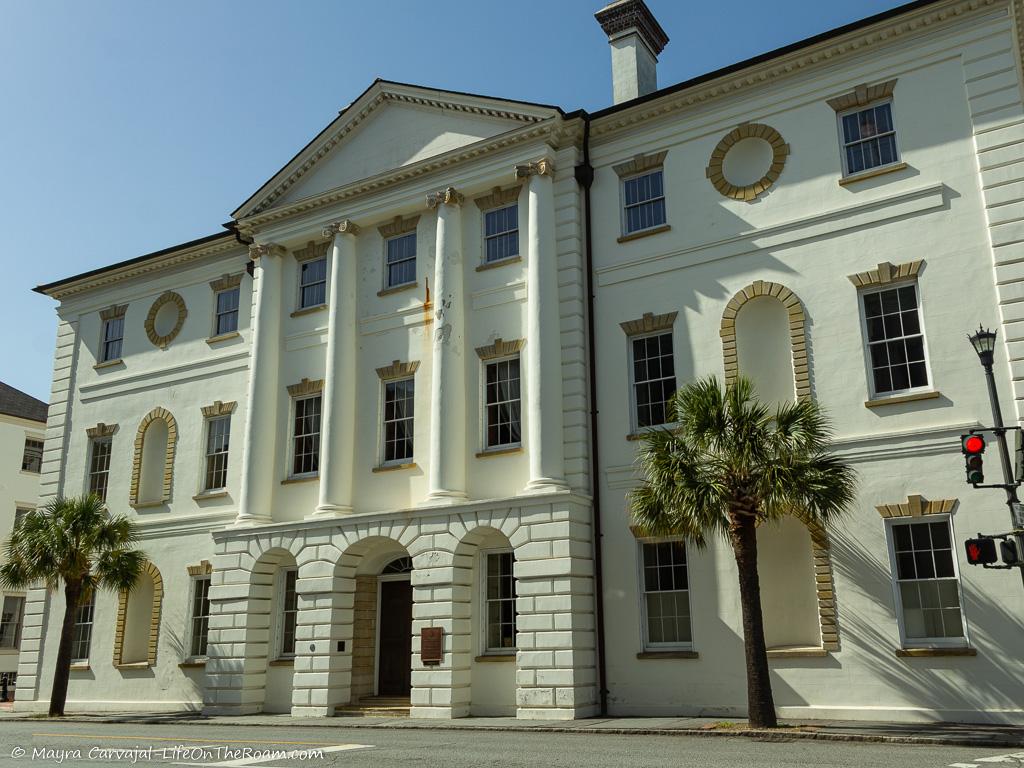
Federal Law (#77) – Museum of Postal History (Federal Courthouse): After a devastating earthquake left the Police Station in ruins, someone came up with the idea to erect a beautiful Renaissance Revival building in its place. In 1896, the US post office and courthouse moved here, along with a small postal museum that you can tour, for free.
In 1942, a District Judge by the name of Waties Waring served here for 10 years. Waring helped propel the civil rights movement when he ruled that segregation in public schools had to stop. Immediately.
God’s Law (71 Broad St.) – St. Michael’s Episcopal Church: You can’t miss the shining 186-feet-high white steeple of the oldest church in Charleston, dating back to 1761, which looks pretty much the same ever since. The stained glass you’ll see in its windows and doors is colourful and beautiful, but the apse framing the glass image of St. Michael takes the cake, flanked by Corinthian capitals and crowned with a richly decorated dome. George Washington worshipped here in 1791 when he visited Charleston.
Check out the gorgeous iron gate of the cemetery next door.
State Law (84 Broad St.) – The Charleston County Courthouse: The original building is from 1753 and it was designed to show off the status of Charleston during the Colonial period. After a fire destroyed it, the reconstruction work was completed in 1792, in a neoclassical style.
City Law (80 Broad St.) – Charleston City Hall: This Adamesque-style building was completed in 1801. It was designed by Gabriel Manigault to house a local branch of the First Bank of the United States. The history of the site goes back to 1672 when it was used for a marketplace until a fire wiped it out. It has been the City Hall since 1818.
Take a break at George Washington Square (80 Broad St)
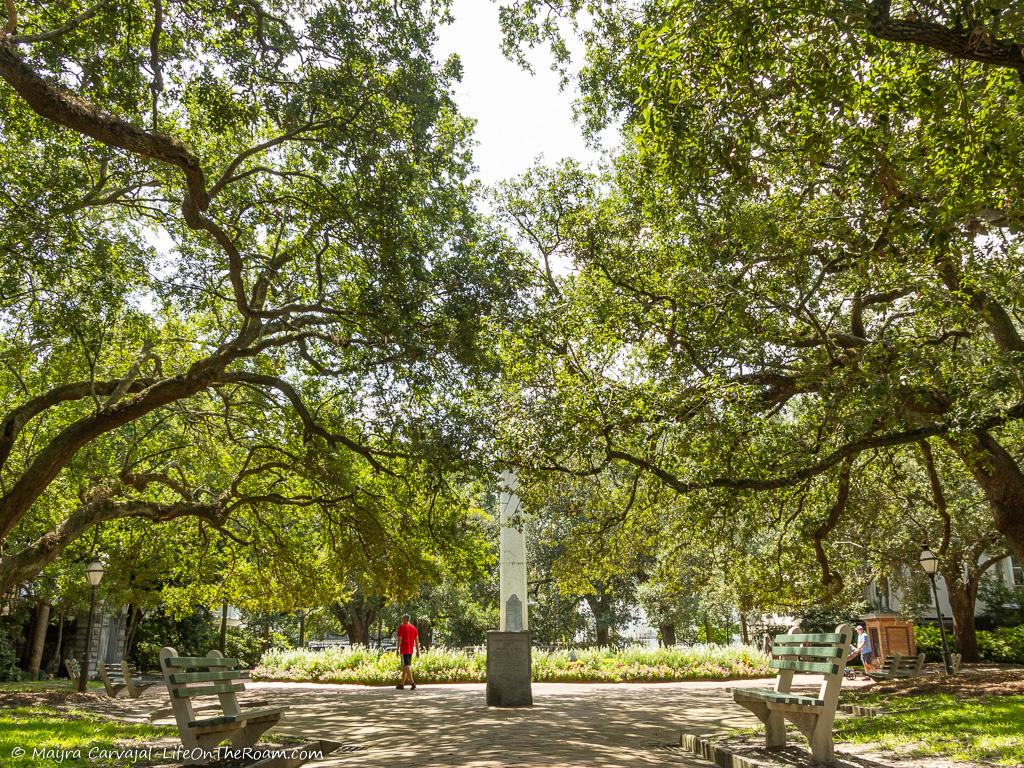
A good place to take a break while looking at huge live oak trees before resuming your architectural tour.
When you’re ready to get back on your feet you’ll see two more interesting civic buildings.
The County Records Building (#100), built in the early 1820s, is known as The Fireproof Building because, you guessed it, is non-combustible. During construction, they used stone for the floors and the windowsills, iron for the window frames and sashes, and wood was left out like a cat in a fish shop.
This National Historic Landmark, in Greek Revival style, was the first public building in Charleston.
Another National Historic Landmark is The Hibernian Hall (#105), (c. 1840), in Greek Revival style with a Corinthian pediment and Ionic capitals.

One of the most important events that took place in this meeting hall was the National Democratic Convention of 1860, which resulted in a split in the party, and the election of the Republican candidate: no other than Abraham Lincoln.
Closer to current times and in a more festive tone, fans of green beer gather here to throw massive St. Patrick’s Day celebrations. Cheers!
History & Cocktails: learn about the prohibition period at a Charleston speakeasy mixing history with a cocktail class. In 2 hours you try 3 prohibition-era cocktails and make your own concoction.
Book this fun experience, with a rating of 4.9/5 based on more than 290 reviews.
History & Cooking Class: combine a 1.5-hour historical walking tour about Charleston’s food and watch a cooking demo from a certified chef-guide. Enjoy a 3-course lunch paired with wine and take home the recipes.
Learn how food connects with history, with a rating of 5/5 based on more than 850 reviews.
Our last stop along Meeting Street before exploring Broad Street is The Mills House Hotel (#115).
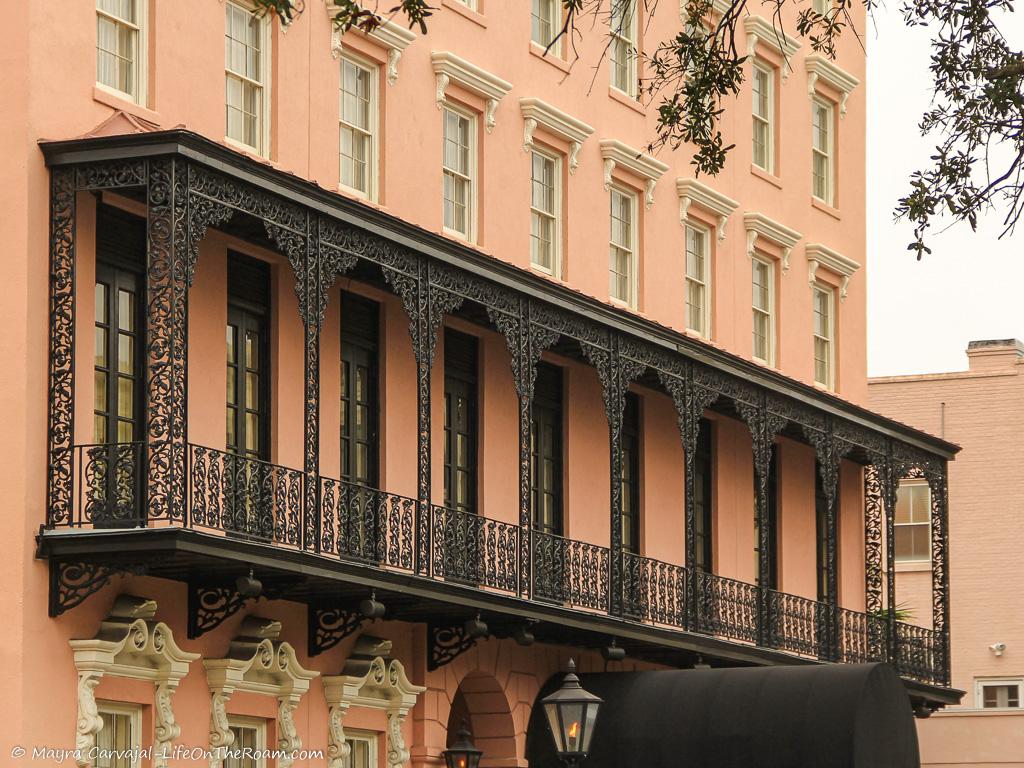
Even though this pink hotel was rebuilt in 1968, most of the fabulous ironwork you see in the exterior is original, as well as most of the cornices, and some other architectural details.
It was first built in 1853 and it has seen many famous guests walk through its hallways, including President Theodore Roosevelt. You can join the distinguished guest list by staying at the Mills House.
\
The Charleston Architecture along Broad Street
Only three blocks from our last stop in Meeting Street (The Mills House Hotel) you’ll find The Cathedral of St. John the Baptist (#120) (c. 1907).
This brownstone cathedral in Gothic style has a unique look, different from any of the other churches in the city. Look closely and you’ll see the perforated reddish sandstone arranged in a brick pattern.
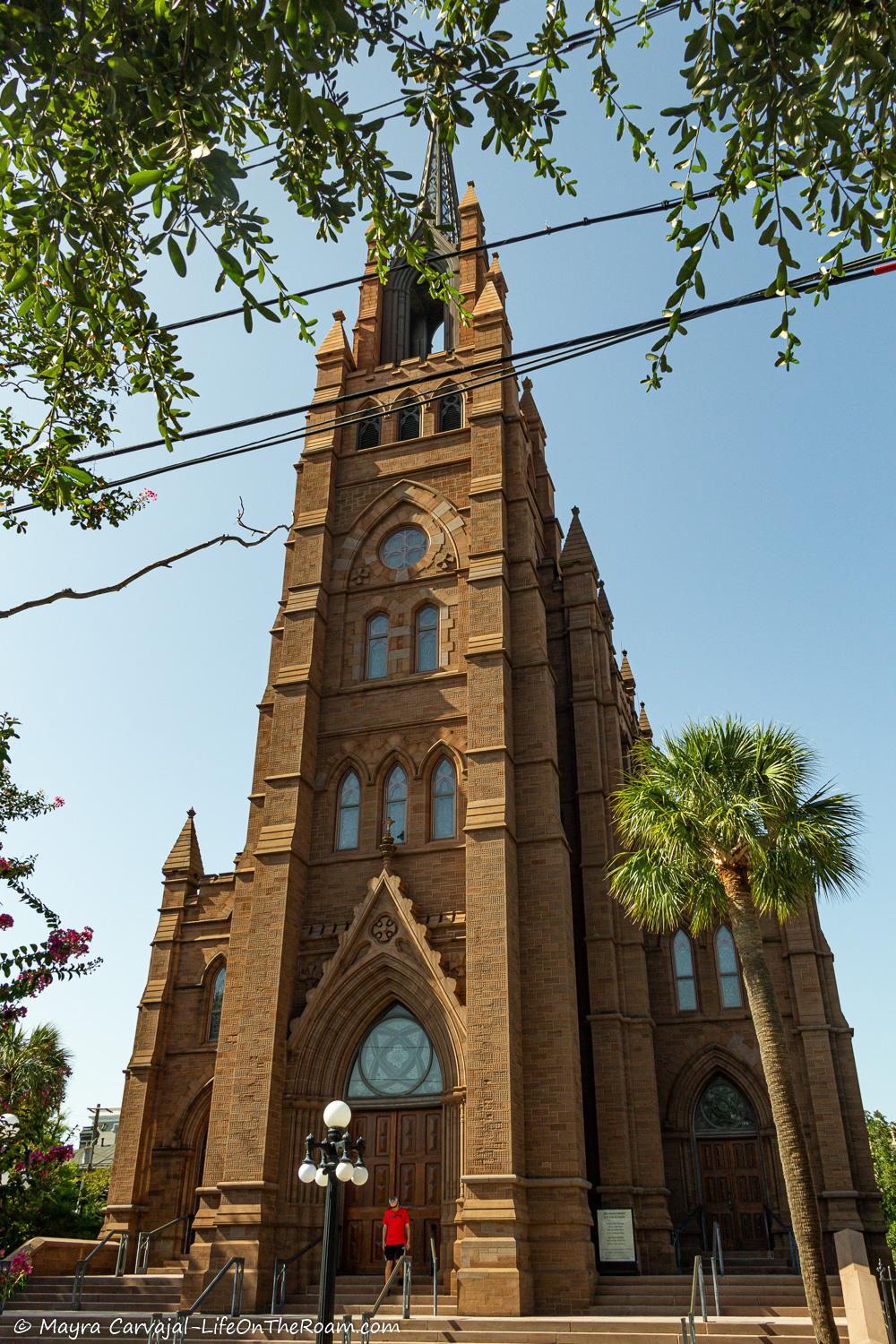
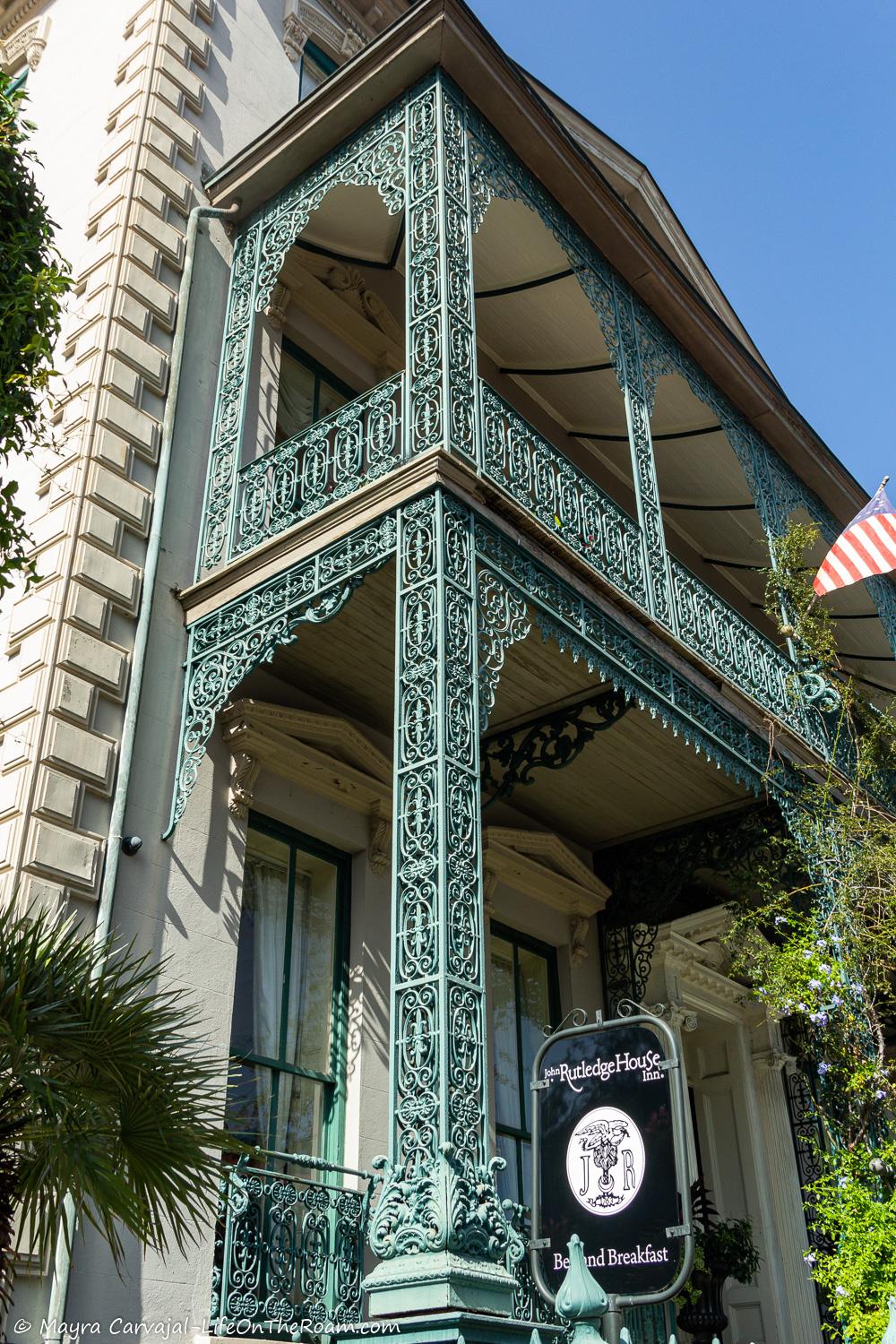
If you have room for another ironwork masterpiece (I never say no to that), stop at The John Rutledge House (#116), the residence of the first governor of South Carolina and signer of the US Constitution in 1787. It’s now a bed and breakfast where you can stay. The magnificent ornamental iron was added in 1853.
Now head East towards the waterfront to visit a section of Broad Street with several art galleries. Soft pastel and white buildings create a postcard image under the watchful eye of St. Michael’s Church pure white.
The Joseph P. Riley (#13) is one of my favourite buildings in this part of town. I also loved the ornamental iron on 16 Broad Street.
You’ll reach our last stop at Broad Street before you head to the waterfront and explore the French Quarter.
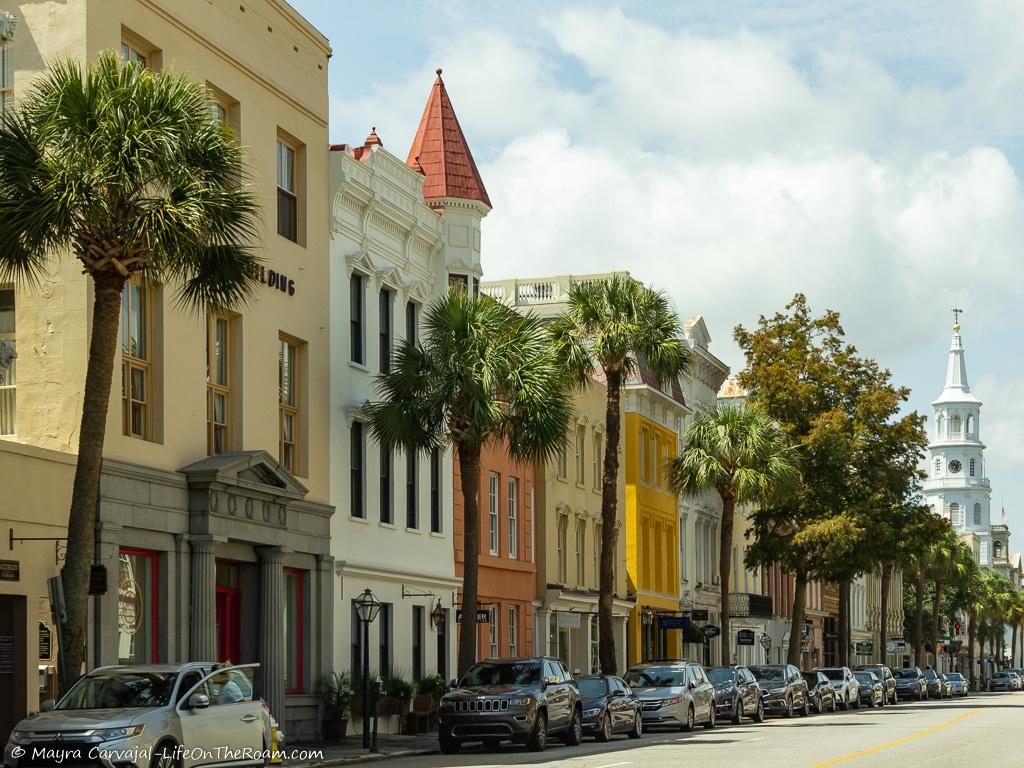
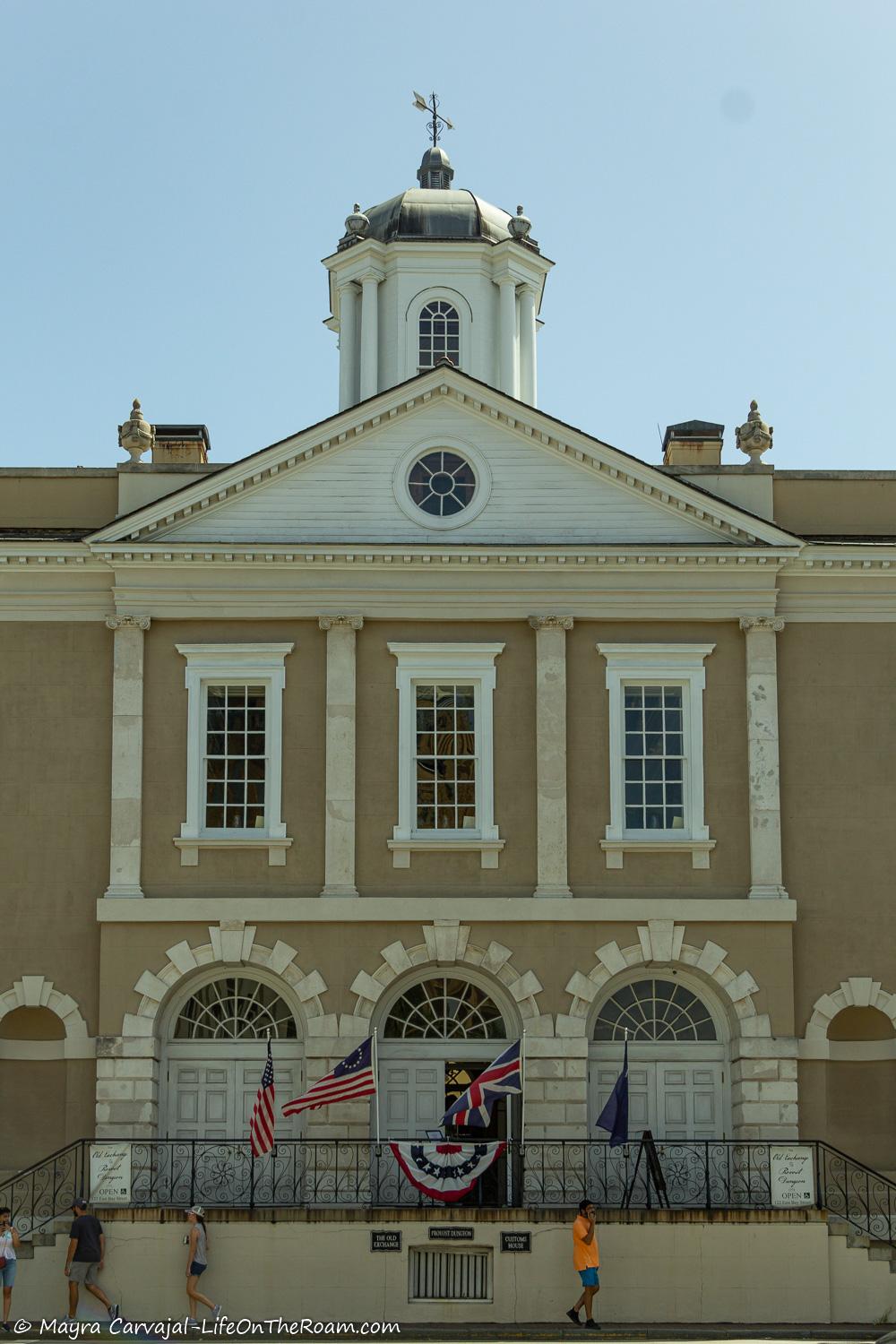
The Old Exchange and Provost Dungeon (122 East Bay Street at the intersection with Broad Street) is a National Historic Landmark that claims to be South Carolina’s most historic building. Since the Constitution of the United States was ratified within these walls in 1788, I would say they’re entitled to make that claim.
The Old Exchange (it was built as an exchange and customs house in 1771) is a Georgian Palladian structure that hosted massive parties for Charleston’s elite and had distinguished guests such as the first president of the country, George Washington.
But it also holds an obscure past, don’t forget the “Provost Dungeon” part of the name. The bottom floor served as a prison during the Revolutionary War and beyond, holding enslaved people.
The Exchange was a popular site to hold public slave auctions, where thousands of American-born enslaved people were sold.
The site is now a museum where you can join tours and learn about the American Revolution.
The Traditional Charleston Architecture in the French Quarter
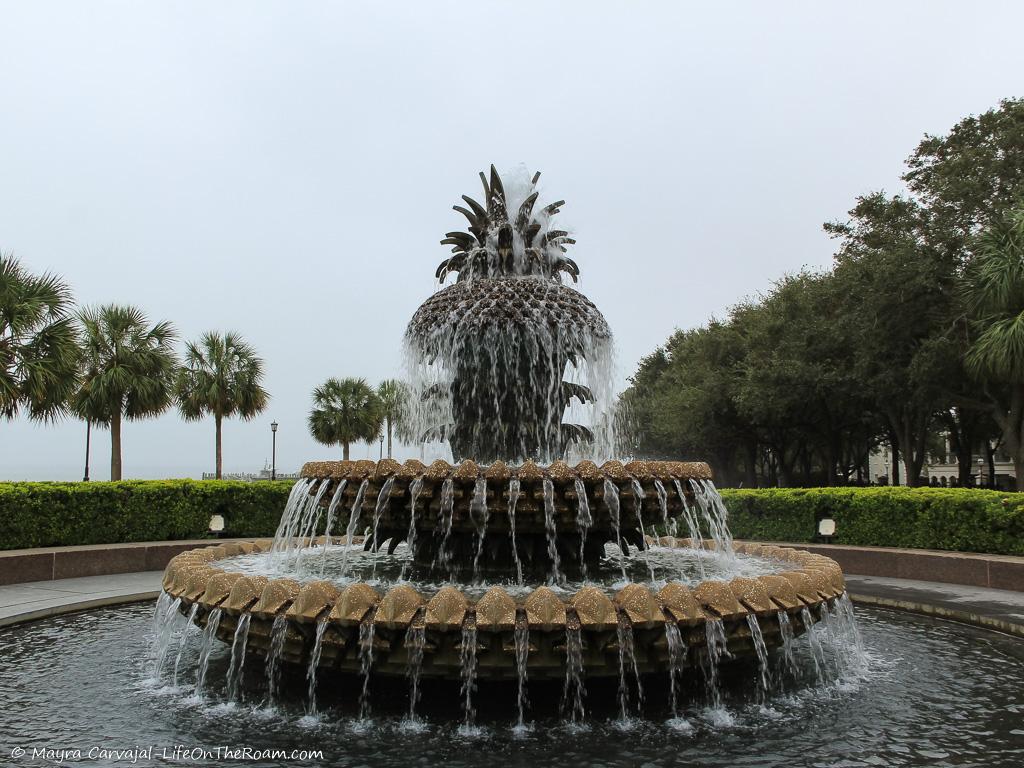
Walk one block East of the Old Exchange building and you’ll find the Joe Riley Waterfront Park. Set aside some time to visit this small but lovely park, right on the waterfront, with two emblematic fountains (the pineapple one is my favourite) connected by a walkway under a tunnel formed by the branches of live oak trees and dotted with benches.
Walk along the boulevard where birds hang out in the tall grasses.
You’ll find many art galleries in Charleston, most of them in the southern area. One not to miss is the historic Vendue Boutique Hotel (19 Vendue Range). Their lobby, gallery rooms, hallways, and other public spaces are filled with contemporary art. They also have an artist-in-residence program and tours.
Or you can fully submerge yourself in the experience by staying at The Vendue.
Walk two blocks west to reach Chalmers Street where you’ll see two landmarks.
Charleston was one of the main ports for ships bringing enslaved people to the United States. Some were sold at an auction gallery (c. 1859) until the end of the Civil War. Today, it functions as The Old Slave Mart Museum (6 Chalmers St.) where you can learn about the dark side of Charleston’s history.

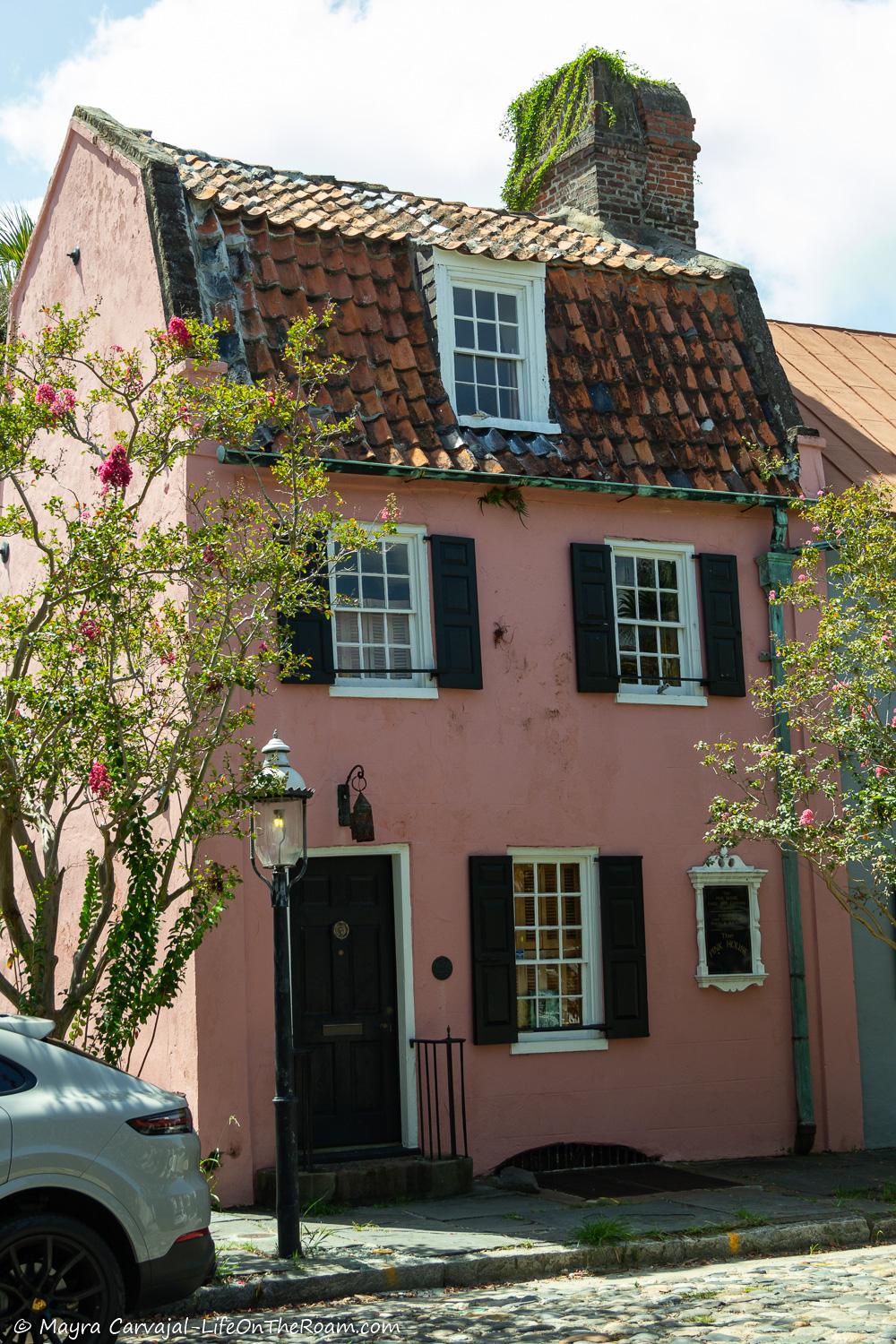
A few steps further you’ll find The Pink House Gallery. Definitely pink, but not a gallery anymore.
This quirky house (17 Chalmers St.) with a funky tiled gambrel roof on a ballast stone street is one of the oldest in Charleston; it goes as far as 1712.
Unlike other buildings in Charleston that used brick covered in stucco to resemble stone, this is the real deal. John Breton used pink Bermuda stone as the building material.
It’s now a private residence, but in the past, it functioned as an art gallery, as an office, as a tavern, and rumour has it that it was a brothel at some point.
Quite ironic as the house could very well spring out of a children’s book.
From here go to 135 Church Street to see the Historic Dock Street Theatre, the first building in the United States to be designed as a theatre from the get-go.

It’s hard to take your eyes off the exquisite wrought iron of the balcony (added in 1835) sitting above the recessed porch entrance. The brownstone columns below, crowned with carved wooden brackets, make the entrance look solid and airy at the same time.
The original building, from 1736, has been reconstructed and restored several times.
The first calamity happened in 1740 when a fire burnt it to the ground. Later it was reconstructed as a hotel and then used as an apartment building until calamity number two (an earthquake) happened and the place was abandoned.
In 1934 someone screamed Let’s save this treasure!, and the Dock Street Theatre was born.
The most recent works took place in 2010.
Interested in seeing how it looks inside but you don’t have tickets for a show? You can book a tour to visit the renovated, beautiful interiors, including the seating area. Highly recommended.
Nowadays you can enjoy concerts, operas, performances and other events such as the Spoleto Festival USA each spring.
Just a few steps from here you’ll find two churches: The French Protestant Church (136 Church St.) and St. Philip’s Church (#142).
Around the 17th century, the French Catholic Court (and Louis XIV) didn’t make life easy for Huguenots (French Protestants), forcing them to escape religious persecution. They found in Charleston a safe place to worship as they pleased.
The church you see on site -the first Gothic Revival building in Charleston- was built in 1845.
I loved the bubble gum colour of its walls (repainted to match its original pink). The builders used bricks and stucco to resemble stone and match the aesthetic of the Gothic Revival style.
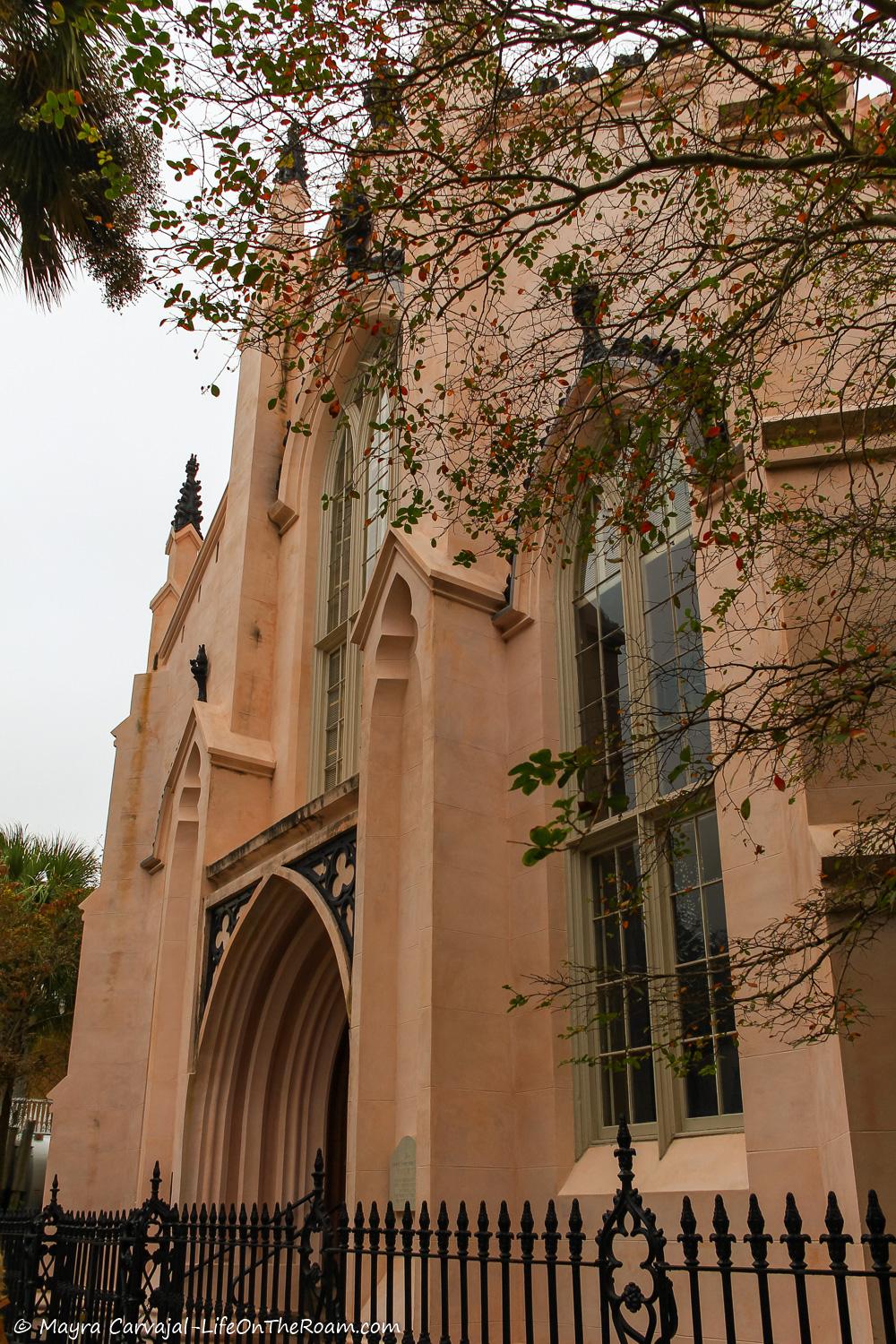
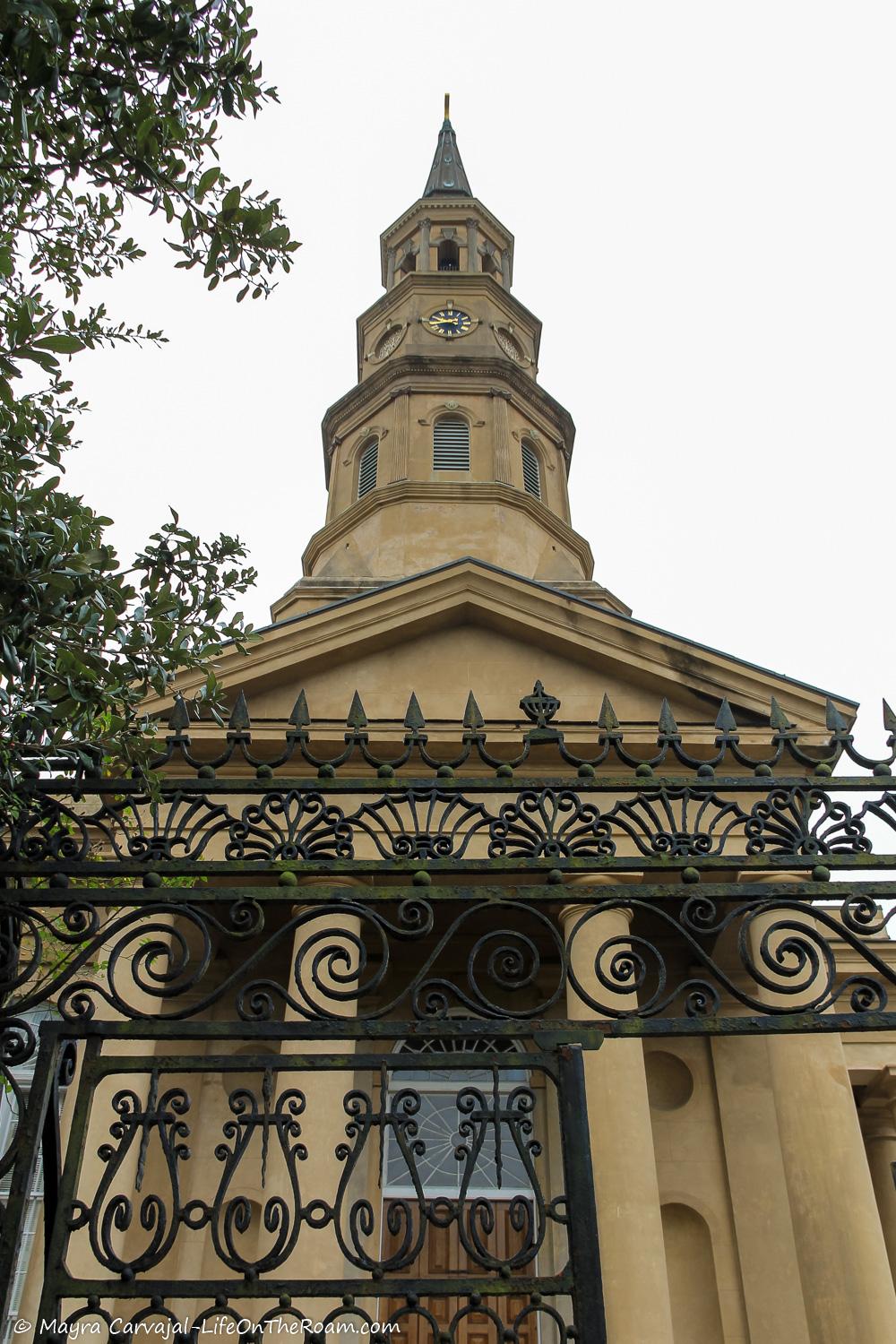
Next, you’ll find St. Philip’s Church. You can’t miss its distinctive steeple in Charleston’s skyline.
The congregation of St. Philip’s dates back to 1680, making it not only the oldest in South Carolina, but the oldest in the US, south of Virginia.
After a fire destroyed the original building on site (from 1723), a new one replaced it in 1838, designed by architect Joseph Hyde in an Anglo-Palladian style.
Even more beautiful than the church are its iron gates and fences, completed by the talented Philip Simmons.
Right across the street, you’ll find the West Cemetery, with dreamy oak trees. The gates are one of the few original pieces of wrought iron surviving the American Revolutionary War in the city.
Walk along the Famous Charleston’s Rainbow Row
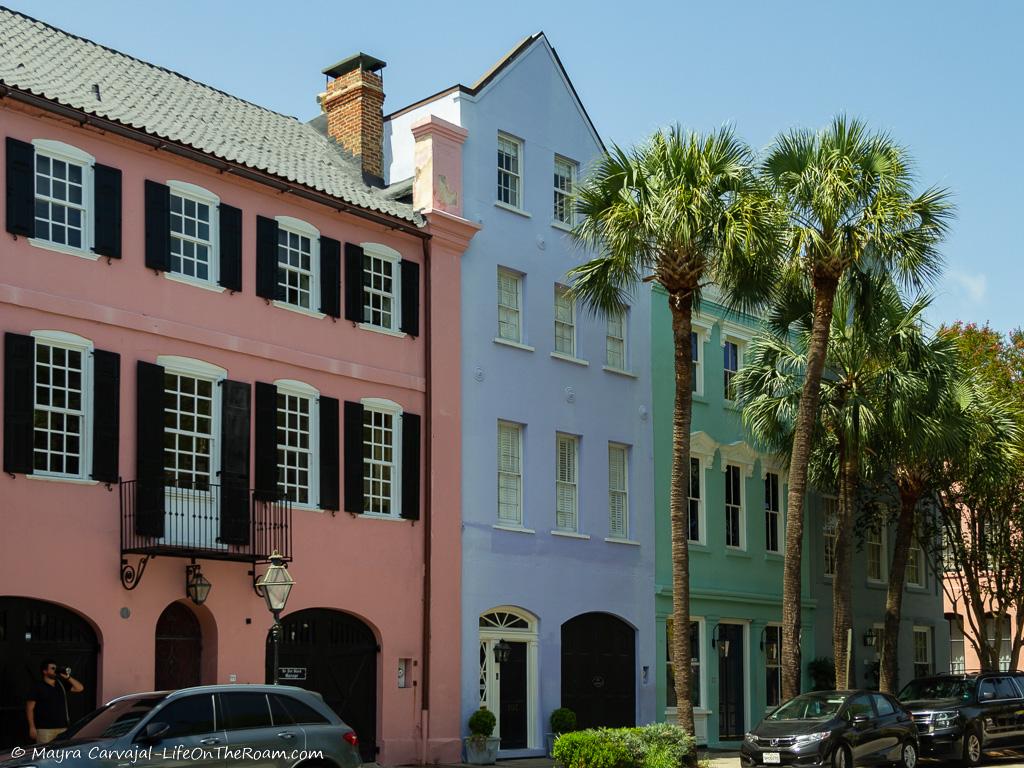
You’ll find this row of Georgian-style houses along East Bay Street (#83 – #107). Their bright pastel colours make them impossible to miss. When you see it all pretty now it’s hard to imagine that this section was all run down after the Civil war, until one owner decided that it was time to turn things around and take care of her houses.
After some renovations and many cans of paint the love of colour spread like a funny meme, and all the owners were on board.
Today, it’s one of the most photographed spots in Charleston.
Planning a trip to Charleston? With its historic architecture, slow-paced rhythm, and scenic coastline, this historic city checks all the boxes to earn a spot in your itinerary.
Share this post with someone who loves architecture and it’s planning a trip to the South.
YOU MAY ALSO WANT TO READ
BOOKING FLIGHTS AND ACCOMMODATIONS
Book your flight without losing your shirt
We check Momondo to find great deals to book our flights. Also, check Great Escape: it combines the listings from Expedia, Kiwi, Kayak, (and Skyscanner on the premium service) to find the best airfares.
To find a place to stay for less
Booking.com: you’ll find any type of property you can think of in their massive listing, with one of the most comprehensive filters. We’ve found great deals on boutique hotels, apartments, and private rooms in hostels.
Hotwire: the first site I check when we plan to stay at a hotel for a few nights. You can save anything from 20% to 60%. Use the search filter to find what you want and you’ll end up with three listings that match your criteria. You’ll know which one you’ll get after you book. If you can handle a little bit of uncertainty you can score big savings.
House Sitting: you take care of people’s pets and house for free while staying for free. It’s the closest thing to experiencing a place “like a local”. But it comes with responsibilities… Are you an animal lover? It may become your new way to travel.
To get travel insurance
SafetyWing: travel medical insurance that gives us peace of mind knowing that we’re covered in case of emergency. It’s convenient, affordable, and suitable for digital nomads who spend a long time outside their home country.
Check the full list of travel resources on my Resource Page for more options and savings
